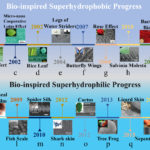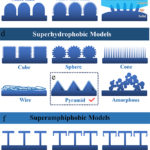Bioinspired Designs of Superhydrophobic and Superhydrophilic Materials
Bioinspired designs of superhydrophobic and superhydrophilic materials have been an important and fascinating area of research in recent years for their extensive potential application prospects from industry to our daily life. Despite extensive progress, existing research achievements are far from real applications. From biomimetic performance to service life, the related research has faced serious problems at present. A timely outlook is therefore necessary to summarize the existing research, to discuss the challenges faced, and to propose constructive advice for the ongoing scientific trend. Here, we comb the process of development of bioinspired superhydrophobic and superhydrophilic materials at first. Then, we also describe how to design artificial superhydrophobic and superhydrophilic materials. Furthermore, current challenges faced by bioinspired designs of superhydrophobic and superhydrophilic materials are pointed out, separately, and the possible solutions are discussed. Emerging applications in this field are also briefly considered. Finally, the development trend within this field is highlighted to lead future research.
Learn about our two Decals!
 Click here to find out more about our Fall Bioinspired Design Decal and our Spring Bioinspired Design in Action Decal – ALL MAJORS are welcome.
Click here to find out more about our Fall Bioinspired Design Decal and our Spring Bioinspired Design in Action Decal – ALL MAJORS are welcome.Berkeley BioDesign Community
 Click here to learn about the BioD: Bio-Inspired Design @ Berkeley student organization or here to signup for more info.
Click here to learn about the BioD: Bio-Inspired Design @ Berkeley student organization or here to signup for more info.Search
Student Login





I imagine that the neurological circuits underlying these processes are governed by both 2d spacing maps with their brains as…
to reduce the impact of car accidents, it may be possible to study the force diverting physics of cockroaches to…
you see this type of head-bobbing stability in many avian creatures related to pigeons like chickens. the head ability to…
not like they taught horses how to run! this is an example of convergent evolution where both sea creatures and…
The brain functions in a similar way with neuronal connections. our brains are able to utilize the multiplicity of connections…